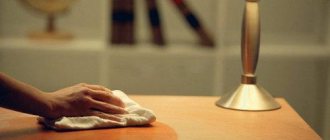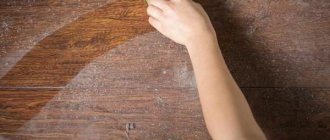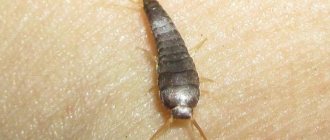After wet cleaning, within a few hours all surfaces are again covered with a thin layer of dust. Moreover, this happens both with the windows wide open and with the vents and doors tightly closed. Nothing can be done about dust settling, but there are ways to minimize this process, which is very important for people suffering from allergies or diseases of the bronchopulmonary system. Let's figure out where dust comes from and what ways to deal with it.
Where does house dust come from?
Dust is tiny particles with a diameter of up to 0.1 mm that enter homes through windows and ventilation, as well as on the soles of shoes. The inhabitants of the home themselves become effective “producers” of dust: it contains flakes of human skin, dander and pet hair. You can also find insect remains, feather fragments, fungal spores and particles of various building materials in it. Every day, Exposure Factors Handbook / US Environmental Protection Agency from 30 to 60 mg of dust enters our body.
Scientists recently conducted a study International Analysis of Sources and Human Health Risk Associated with Trace Metal Contaminants in Residential Indoor Dust / ACS Publications of house dust from 35 countries around the world. Depending on the city, arsenic, lead, chromium, nickel, manganese and other elements dangerous to the body were found in it. Dust mites, which feed on dead particles of the human epidermis, also pose a threat to health. Their secretions are often the cause of Dust mite allergy / Mayo Clinic allergies and asthma. Therefore, people with such diseases should approach the battle with dust thoroughly.
Sources and composition of dust
Dust is a finely dispersed suspension that is constantly present in the air. It is found in all corners of the earth, and air masses carry it over vast distances. The common dust that covers the furniture in our apartments contains sand from various deserts, volcanic ash, evaporating mineral particles that were once part of sea water, and even elements from distant stars.
The most active sources of dust on earth are deserts. In addition, the winds blow away tiny parts of any type of soil and carry them far from their home. The largest dust particles come to us from volcanoes, where there is a lot of ash from previous eruptions. Another component of dust is the combustion products of oil, peat, coal, and also those released into the air during large fires. Cosmic dust also settles on Earth, brought with it by comets and asteroids flying close to our planet.
The source of dust is both humans and domestic animals. The smallest horny particles of skin are constantly exfoliated from the body and join the air mass. Plants also contribute to the community by producing pollen when they bloom.
The composition of ordinary household dust in percentage terms looks like this:
- about a third (about 35%) are various minerals;
- a fifth (19–20%) - dead skin cells of humans and animals;
- about 12% - textile fibers and small particles of pulp and paper products;
- approximately 7% is plant pollen;
- 3% - decomposed organic matter, combustion products;
- another 3% are tiny microorganisms;
- It is not possible to establish the identity and origin of the remaining part.
In residential areas, sources of dust include people, animals, clothing and furniture (especially soft furniture). In addition, it is carried into the house on shoes and penetrates through ventilation openings, windows and doors. There is a lot of it in the apartments of residents of large cities, especially if the house is located near transport routes, construction sites, and industrial enterprises.
Do not create favorable conditions for dust
Minimize the number of dust collectors in your home. Various figurines, vases, travel souvenirs, soft toys and other decor will certainly please the eye. But at the same time they collect a lot of dust, and fighting it takes time and effort. It is also worth removing from open surfaces things that you do not use daily: cosmetics, perfumes, jewelry, dishes, stacks of papers. Carpets are considered one of the leaders in collecting dust. If you cannot refuse them, you will have to periodically give them a thorough cleaning.
How to prevent dust in your home
Prevention of a problem is the simplest method of solving it. Therefore, if you want to get rid of dust comprehensively, you should reconsider the interior. First of all, remove the carpets. No matter how carefully they are processed, they attract dust to themselves, and lint particles are additional sources of dust. You should also replace pillows with natural fillings made of feather, down and wool with modern ones, with bamboo fiber, buckwheat husk or foam. Such materials bring several times less harmful particles into the house.
Regular cleaning and ventilation is a prerequisite for keeping the apartment cleaner.
When purchasing modern air filtration systems, it is necessary to ensure that the filter cassettes are clean. They need to be cleaned and replaced as needed.
When cooking food, you need to turn on the hood. It will help prevent small particles from food from getting into the air.
Do wet cleaning more often
The advice is as old as the world and has still not lost its relevance. Damp cleaning is not only aesthetic, but also medical. Controlling Dust, Dust Mites, and Other Allergens in Your Home / Michigan Medicine: University of Michigan, especially if you suffer from allergies and asthma. We arm ourselves with a rag. It is better if it is made of microfiber. You can easily collect all the dust with a dry one, and then seal the result with a wet one.
It’s also convenient to use a fluffy broom with the funny name “pipidastr” to combat dust. Its synthetic fibers do not brush away, but attract particles, which significantly speeds up cleaning even in hard-to-reach places.
Provoking factors for dust accumulation
Dust is present on all surfaces in the house, but there are places and objects where it lingers better, but is less easily removed. Interestingly, in a standard three-room apartment, up to 40 kg can accumulate in a year. The best dust collectors are:
- carpet floor coverings;
- carpets and rugs, both synthetic and natural wool;
- children's soft toys;
- curtains and curtains made of dense heavy materials, especially covered with pile, for example, velvet or velor;
- clothes laid out outside closets and chests of drawers, old rags, printed materials;
- various household equipment that perfectly attracts dust particles due to static electricity.
The dustiest places in the apartment are the back surface of the refrigerator and the floor spaces under large furniture (wardrobes, sofas).
Humidify the air
The most effective way to combat dust is to buy a humidifier. Pay attention to how much area of the room the device can cover. More expensive models have additional air purification and ionization functions. You can also increase the humidity in your apartment using household methods. For example, after a shower, leave the bathroom door open, hang wet laundry on the radiators, or place a bucket of water near the radiator. A nice bonus: air humidification has a good effect on the condition of the skin and hair, especially during the heating season.
How to get rid of dust: cleaning features
To make your home more comfortable and reduce the amount of harmful particles in the air, there are some cleaning tricks that do not take much time, but are very effective. First of all, it is necessary to ventilate the room daily by opening the window wide, which should be protected by a mosquito net. You also need to wipe the surfaces with a damp cloth at least every other day. Water is the main assistant in the fight against dirt. It is necessary to move massive furniture aside for wet cleaning regularly. If the cabinets have plinths, this makes the task much easier. It doesn't take long to remove them and put them back in place.
The most effective tools for fighting dust
Since the problem of pollution is very widespread, new ways to combat it appear regularly. Indoor household appliances with an air filtration system that capture even the smallest particles that settle on special filters have long been in use. It is enough to change or wash them in a timely manner, and the air in the room will become much cleaner. Modern vacuum cleaners are also equipped with special filters, which not only remove debris from surfaces, but also purify the air.
Humidifiers
A great helper for fresh air is a humidifier. He does his job perfectly. The fact is that dust particles and water have different charges, so water droplets attract dust in the air, it settles on the surface and it becomes much easier to remove them. However, if the humidity in the apartment is high, then the use of such devices can lead to another problem - the formation of mold, so before deciding to purchase such a device, it is better to clarify how high the water content in the room is.
How to remove dust from wallpaper and ceiling
Wet cleaning of floors and surfaces is done regularly, but many people forget about the walls and ceiling. In order to clean them, you can go through them once a week with a vacuum cleaner with a soft attachment or a special broom. These are gentle methods that will significantly improve the microclimate in the house. Without harming surfaces. If the finishing materials of the walls and ceiling allow it, then wet cleaning can also be done. This applies to suspended ceilings, film or fabric, and modern vinyl or non-woven wallpaper, as well as decorative plaster. These materials are not afraid of moisture, so it makes sense to carry out wet cleaning at least once a season.
How to clean a radiator from dust
Batteries, especially if they are hidden by a decorative screen, are a place where you can always find good deposits of dust. They need to be washed once a month. There are no problems with cast iron radiators, the hand can easily fit between the sections, and they are very easy to clean, but bimetallic or convector ones require skill. To clean them, you can use a bottle brush, which will do an excellent job of removing dirt. Blowing with a vacuum cleaner will also help a lot. When it comes to batteries, the key is regularity. If you don’t forget about them during the cleaning process, then there won’t be any problems.
How to wipe furniture to prevent dust from settling
Stores sell a lot of products with an antistatic effect that protect furniture surfaces from settling dust particles. With regular use the difference is obvious. However, if you don’t have specialized chemicals at hand at the moment, you can add half a capful of fabric softener to 2.5 liters of water and wipe the furniture with this mixture. This liquid also contains an antistatic agent that will repel dust from the surface, so it will stay clean longer.
We recommend:
How to remove sealant from clothes at home
Products that help fight dust
To prevent dust from appearing in your home you will need:
- Small dust particles will not settle on furniture if you pre-treat it with a polish containing an antistatic agent. An additional advantage will be the appearance of the surfaces - they acquire a glossy effect.
- For household appliances (TVs, computers), you should choose a special antistatic agent that can be used when the monitor is on.
- Sprays that kill dust mites are commercially available for walls, carpets and textiles. However, they should be used extremely carefully and no more than once every six months.
- Upholstered furniture will require special impregnation, which forms a protective layer, preventing dust from penetrating into deep layers.
Before using a dust remover, it is recommended that you carefully read its instructions.
Useful functions and dangers of dust
Dust, without a doubt, is harmful to human health, but it also has positive functions, because there is nothing on our planet that would be completely useless. The dust suspension in the air absorbs part of the harmful solar radiation. Present in some quantities in various atmospheric layers, it takes part in climate regulation. In addition, fine particles carried by air currents are necessary for the formation of clouds and rain clouds.
Inhalation of dust is extremely harmful to humans. Some people may experience a strong immunological reaction to the penetration of even a small amount of small particles. This is due to the fact that the immune system perceives particles penetrating the respiratory tract as dangerous foreign agents and begins to actively respond to them.
Constant inhalation of dust leads to the development of severe diseases of the bronchopulmonary system. Most often, such pathologies affect those who constantly live or work in a very dusty place. Large construction dust causes the greatest harm to the respiratory tract. There are occupational diseases such as pneumoconiosis. These include the following:
- silicosis, which develops from constant inhalation of air containing silica particles;
- asbestosis, which occurs as a reaction to asbestos-containing dust;
- anthracosis - coal and others.
It is also harmful to breathe ordinary household dust, especially in large quantities. This also leads to the development of respiratory diseases, although not as quickly as in the case of occupational hazards. The most dangerous are particles of mineral substances, the main source of which can be called thermal insulation materials used to insulate apartments.
Another danger of dust is that it is a favorable environment for the development of dust mites. They live and reproduce in pillows, mattresses, upholstered furniture, and bedspreads. These microscopic organisms can cause asthma. Parasites feed on horny particles of skin that a person loses every day. The waste products of dust mites can provoke allergic reactions.
Ideal “dust collectors” in our apartments
The amount of dust in an apartment also depends on its interior. There are a number of things that attract small gray particles, which will not be so easy to remove. These include:
- Carpeting. A huge amount of dust “sticks” to the small fibers on your rug every day, and to maintain relative cleanliness in the room you will have to vacuum the floor daily and periodically wet clean the carpet.
- Unnecessary trash. How much dust boxes and suitcases can collect, lying idle for years in closets and on mezzanines! And also things that are rarely used by the owners, but are in plain sight. The fight should begin precisely with these “deposits”, throwing away everything unnecessary, and what you use from time to time is better to put in boxes and remove from there as needed.
- Collectibles. Another ideal “dust collector” is an object standing on a shelf: a figurine, a model of a car or sailboat, a plush toy. To save yourself the hassle of regularly cleaning parts of your collection, it’s best to store them behind glass.
- Thick curtains and canopies. These interior items literally attract dust particles and small debris; it is much better to replace them with light tulle or blinds.
- Heating batteries. Dust enters the home through windows, and radiators are usually located under them, and many particles settle here.
All of these items contribute to the accumulation of a lot of dust in the room, which is difficult to get rid of.











